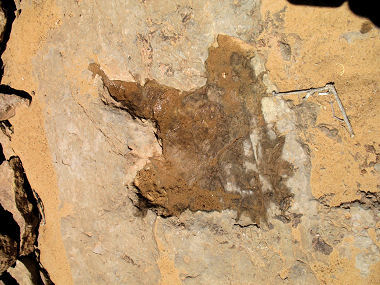Fossilized dinosaur tracks are forms of
trace fossils (also
 known
as ichnites or ichnofossils). Unlike body fossils, which are the remains
of dead bodies, trace fossils record the active movements and behaviors
of ancient organisms. known
as ichnites or ichnofossils). Unlike body fossils, which are the remains
of dead bodies, trace fossils record the active movements and behaviors
of ancient organisms.
|
The dinosaur footprint at right
was photographed in Horseshoe canyon in Canyonlands National Park,
Utah. |
Tracks are formed when
a dinosaur walked along a moist but firm, fine-grained sediment
leaving an impression. The tracks then had to be exposed for a short
while, allowing them to become drier and harder (and able to resist
damage during subsequent burial). These hardened footprints are then
gently buried with additional sediment. The most distinct tracks are
formed when filled by sediments of a contrasting type (which allows
the layers to separate when later re-exposed). After being buried for
millions of years and subjected to pressure and head, the original
sediment lithofies (turns into rock). Finally, the tracks are
re-exposed in modern times by erosion or other forces.
|

